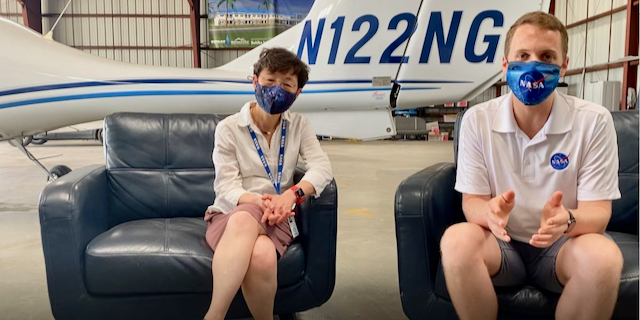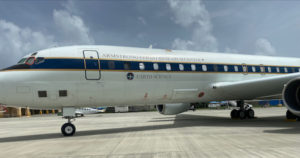
Researchers for the National Aeronautics and Space Administration are on St. Croix this summer as part of a 45-day deployment to research tropical weather and the Saharan dust layer that blows across the Atlantic and interacts with storm and cloud formation.
The team is flying out of Henry E. Rohlsen Airport in NASA’s specially outfitted DC-8 – an airborne science laboratory – as part of a joint effort between NASA and the European Space Agency to gather critical data about tropical convection processes.
Instruments on NASA’s DC-8 will measure winds, aerosols, precipitation, and other conditions that influence convection from the west to the east coast of the Atlantic Ocean near the Equator.
Shuyi Chen, a professor of atmospheric science at the University of Washington, said the tropical convection in the Caribbean is driven by winds’ “intertropical convergence,” which is the wind blowing toward a zone where the convection rises. This is driving both the weather in the local region and how it impacts the United States mainland.
“In the past we took some measurement. This time we have an aircraft equipped with the most up-to-date radar technology. We can sense them much more detailed than we could before. We can sense not only the cloud and precipitation but wind,” Chen said.
Deputy program scientist Aaron J. Pina said the project has several objectives.
“We are here to study tropical weather and the interaction of the Saharan air layer, air that is blowing across the Atlantic Ocean from Africa into the Caribbean and are looking to study the interactions of the Saharan dust with tropical clouds and the formation of clouds,” Pina said.
Chen said all the team’s observations will then be merged into computer models.
“The computer models are what are making the predictions for both weather and climate. Those models are not perfect, they need improvement. These observations are going to inform the computer models and hopefully, the models will improve and do a better job in the future,” Chen said.
Pina said that St. Croix is a great location to be able to observe the Saharan air layer.

“To also be able to fly out and see the formation of tropical clouds and to really be able to fly west or fly east towards Africa and fly south if we need to, especially where we get large storms that rise way high into the atmosphere,” makes St. Croix a good location, Pina said. “We are gathering, measuring a lot of data by being able to fly through the atmosphere.”
Typically, NASA can measure this data from satellites, especially from over the ocean, but they will now be able to improve weather and climate models.
“We can feed more information into these weather and climate models to improve the forecast,” Pina said. “The other thing we will be able to do is we are testing out and looking at the technology on the plane and can we improve NASA technologies to go from airborne.”
NASA will also be able to measure dust from outer space, he added.
“Being able to improve on these technologies we are going to take the results that we have gathered here out of St. Croix. And we will be able to inform both the technology and the science.”
Another part of the program is that the next generation of scientists can participate in the research.
“We have more than 15 graduate students with us, and we have another six post-doctorate research scientists that are here training to be the next generation of scientists. They will be joining the workforce for NASA and other research areas in this particular campaign and will contribute to that as a major influence to our field in the future,” Chen said.
Both Chen and Pina also have expressed their gratitude for the hospitality they have felt since arriving on St. Croix.
“We have had really great support,” Chen said.


